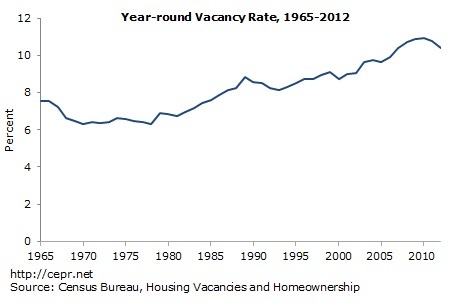January 29, 2013
January 29, 2013 (Housing Market Monitor)
By Dean Baker
The vacancy rate is still far above normal levels.
The January reports on the housing market continue to show evidence of recovery. The Case-Shiller 20-City Index rose by 0.6 percent in November, its 10th consecutive monthly increase. Prices now stand 5.5 percent above their year-ago levels. Prices rose in 18 of the 20 cities, with New York being the only city to show a price decline. Prices in Cleveland were flat.
Other data continue to be mostly positive. The overall vacancy rate dropped to 10.2 percent in the fourth quarter. The rental vacancy rate was 8.7 percent, down by 0.7 percentage points from its year-ago level, while the rate for ownership units was 1.9 percent , down 0.4 percentage points from last year. It is also important to note that units can switch back and forth between rental and ownership. Thirty percent of the rental units are single family houses.
While there were modest drops in new home sales, existing home sales, and pending home sales reported for December, this was largely due to an unusually strong November. The December data in all three categories was far above the year-ago level.
Several cities had large price gains in November. Prices in San Francisco rose by 2.5 percent, followed by Minneapolis at 1.9 percent, Atlanta at 1.6 percent, and San Diego and Phoenix at 1.5 percent. With the exception of Minneapolis and San Diego, these price gains were given primarily by rises in house prices in the bottom third of the housing market.
In San Francisco, prices for homes in the bottom tier rose by 2.5 percent, more than twice the rate of increase of home prices in the other two tiers. They have risen at a 30.6 percent annual rate over the last three months. Prices for homes in the bottom tier in Atlanta rose 3.2 percent in October and have risen at a 44.0 percent annual rate over the last three months.
In Phoenix, prices for homes in the bottom tier rose by 2.9 percent and have risen at a 44.1 percent rate over the last three months. In Portland, where overall prices rose by just 0.6 percent in October, prices for homes in the bottom tier rose by 2.8 percent. They have risen at a 39.7 percent annual rate over the last three months. Prices for homes in the bottom tier in Las Vegas rose 2.2 percent in November and have risen at a 38.0 percent rate over the last three months.
Much of these increases are a bounceback in a segment of the market that had been badly beaten up. The first-time homebuyers tax credit stopped and reversed the fall in this segment of the market well before the bubble had been fully deflated. When the credit ended, the fall resumed and almost certainly led to a severe over-correction. However, the extraordinary rate of price increases in several of these cities almost certainly indicates a considerable role for speculation. This could lead to another price reversal in the months ahead, especially if there is a modest rise in interest rates from their record low levels.
The drop in prices in New York is striking. This market has been notably weak over the last year; it is the only city with a price decline over the last year, with its index being 1.2 percent lower than the year-ago level. The other East Coast cities also were lagging the overall index, with prices in D.C. up by just 0.3 percent in November and prices in Boston up 0.1 percent. For the year, prices are up by 4.4 percent in D.C. and just 2.3 percent in Boston. In general, the East Coast suffered less than other regions during the downturn, so perhaps it is not surprising it now trails the rest of the country.
The bottom tiers of the market in these cities also outpaced the rest of the market. Over the last year, prices for the bottom tier in New York, D.C. and Boston were up 1.2 percent, 9.9 percent, and 4.0 percent, respectively.
Notwithstanding the weakness in the Northeast, the housing market will remain strong in 2013. Prices will continue to rise.







